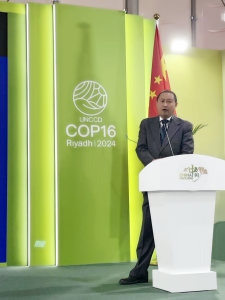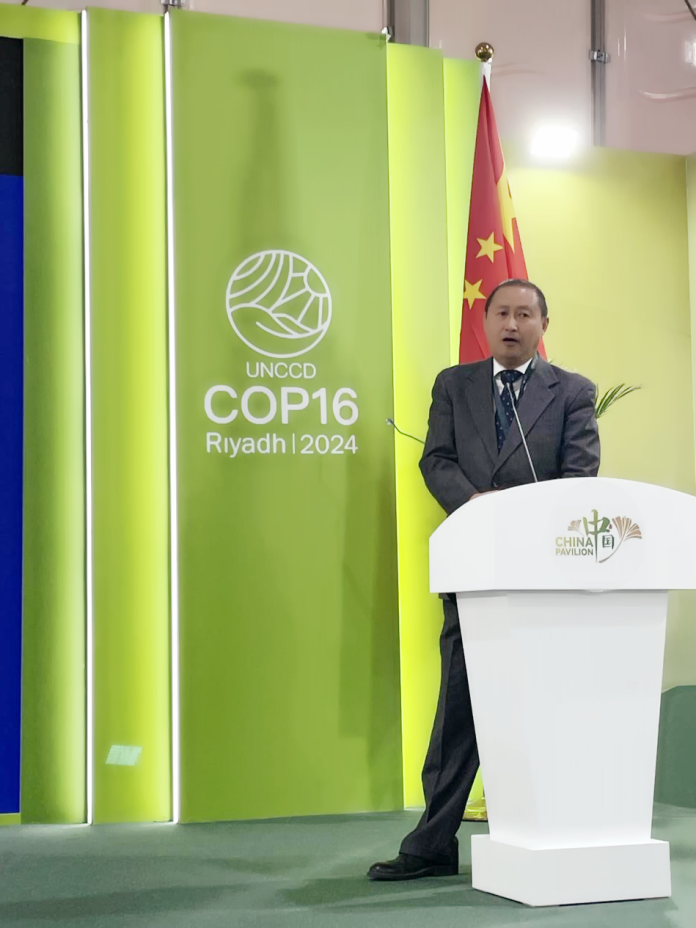[International Energy Network Live Report] On the morning of December 10, the side event titled “Photovoltaic Power Station Planning and Ecological Design in Desert Areas” side event was held at the 16th Session of the Conference of the Parties to the United Nations Convention to Combat Desertification (UNCCD) (COP16) in Riyadh, Saudi Arabia. The side event was hosted by the Center for Energy Transition and Social Development of the School of Social Sciences of Tsinghua University, and co-hosted by the China Renewable Energy Engineering Institute, China National Sand Control and Desert Industry Society, Institute for Carbon Neutrality, Tsinghua University, Ningxia Longyuan New Energy Co., Ltd.
This side event aims to discuss in depth the latest research results, practical experience and innovative ideas on photovoltaic and land desertification control, promote the application of new energy in global land desertification control, and release an initiative on photovoltaic power stations to promote desertification control.
At the meeting, Dr. Yu Yi of Inner Mongolia Yixiang Jiecheng Technology Co., Ltd delivered a keynote report on “A Green and Low-carbon Model for Large-scale Prevention and Control of Desertification”, which introduced the background of large-scale prevention and control of desertification, Green and low-carbon model for desertification control, Biodegradable sand barrier technology for sand control, Nature-based vegetation restoration, Industrialized desertification control, and the benefits of scale-up and its application prospects as well.

Dr. Yi YU, Ph . D Researcher of Inner Mongolia Yixiang Jiecheng Technology Co., Ltd
In 2020, the leaders of the Group of Twenty announced their ambition to reduce the world’s degraded land by 50% by 2040. The international community has pledged to restore 1 billion hectares of degraded land by 2030 based on various international processes, from the Bonn Challenge to the zero land degradation target. However, in practice, it faces the pain points of less than 100 hectares, handicraft-style technical levels and slow fund raising.
Dr. Yu Yi introduced that after years of research, everyone has reached a preliminary consensus that funds, talents, new technologies, participation of private and non-governmental organizations, and the scale and capacity building of vegetation restoration can realize the scale of project operation. To achieve large-scale sand prevention and control and explore green and low-carbon sand control models, sustainability can be achieved from the perspectives of capital efficiency, emission reduction and consumption reduction, cost reduction, full life cycle evaluation, and policy support. “To achieve a green and low-carbon sand control model, we have adopted a model that combines biodegradable sand barrier sand control technology with the concept of near-natural vegetation restoration. The biodegradable sand barrier sand control technology mainly uses the concept of sand control, using biodegradable materials to replace traditional sand control methods, and has the advantage of not requiring roads and transportation conditions.”
Dr. Yu Yi said that industrial sand control combines the large-scale development of the photovoltaic industry with the green and low-carbon sand control model, which can reduce the handling volume by 20-60 times, and adopt a continuous paving method to increase the sand control speed by 3-5 times. The CO2 emissions of manufacturing polylactic acid fiber products are 2.8 times lower than those of chemical fibers. The biodegradable sand barrier maintains the protective effect for 8-10 years, and the average cost is reduced by about 50%, achieving complete biodegradation without residue and fire resistance.
Dr. Yu Yi also said, “The green and low-carbon sand control model has been verified in the Ulan Buh Desert for ten years. The industrial sand control model has been applied to the 1,500-acre large-scale sand control demonstration model of Huadian Inner Mongolia Energy Co., Ltd. and the 3,500-ha polylactic acid sand barrier sand control technology used in the Sanjiangyuan National Park special plan, and the prospects are broad.”






